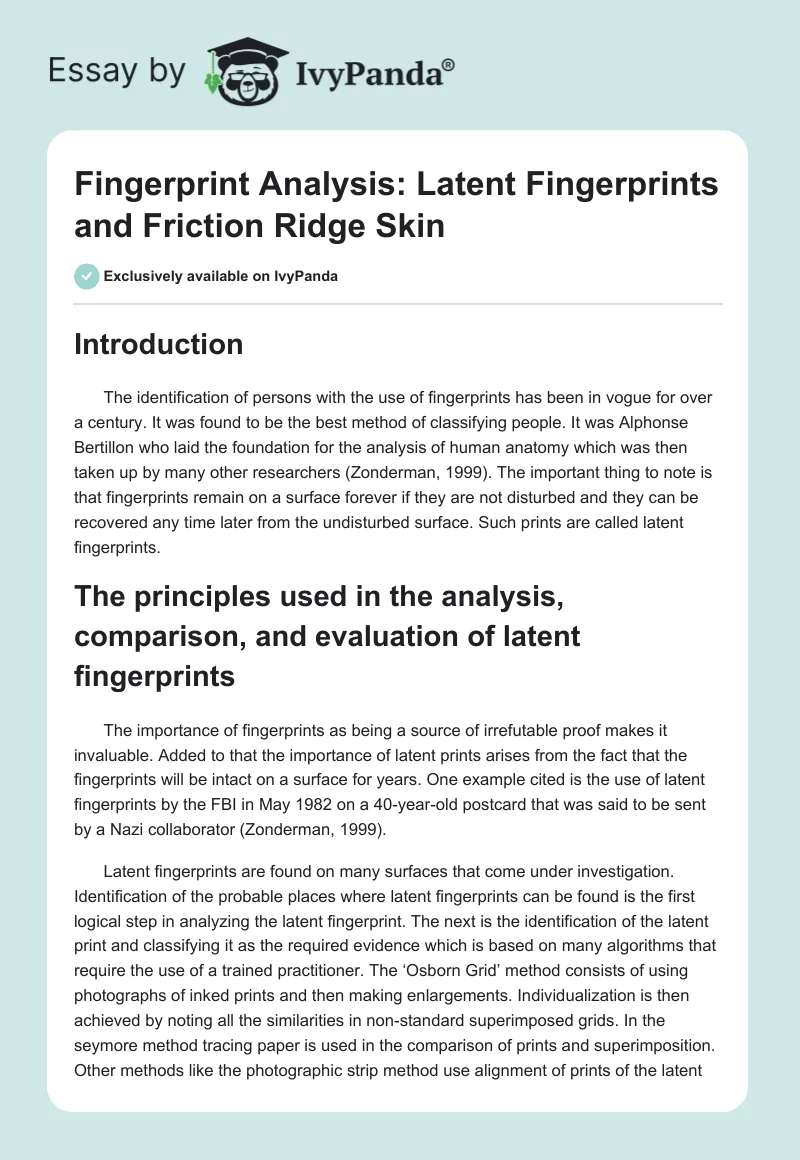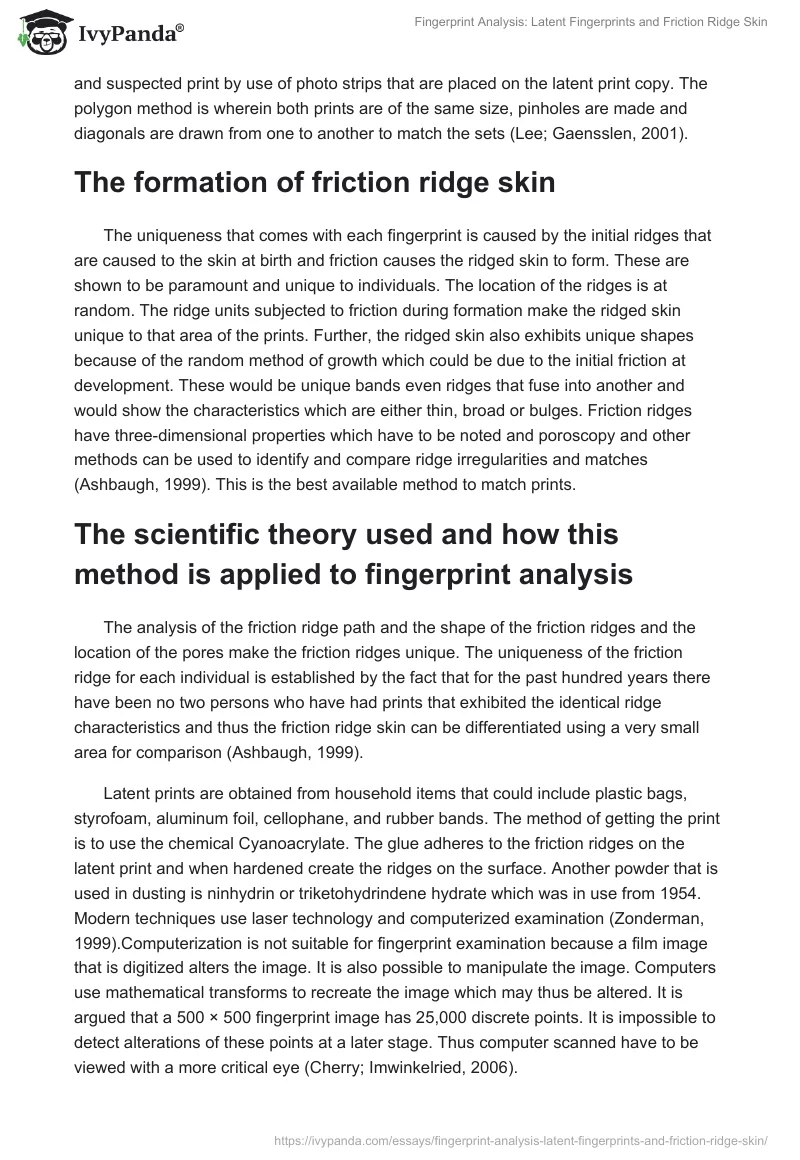Introduction
The identification of persons with the use of fingerprints has been in vogue for over a century. It was found to be the best method of classifying people. It was Alphonse Bertillon who laid the foundation for the analysis of human anatomy which was then taken up by many other researchers (Zonderman, 1999). The important thing to note is that fingerprints remain on a surface forever if they are not disturbed and they can be recovered any time later from the undisturbed surface. Such prints are called latent fingerprints.
The principles used in the analysis, comparison, and evaluation of latent fingerprints
The importance of fingerprints as being a source of irrefutable proof makes it invaluable. Added to that the importance of latent prints arises from the fact that the fingerprints will be intact on a surface for years. One example cited is the use of latent fingerprints by the FBI in May 1982 on a 40-year-old postcard that was said to be sent by a Nazi collaborator (Zonderman, 1999).
Latent fingerprints are found on many surfaces that come under investigation. Identification of the probable places where latent fingerprints can be found is the first logical step in analyzing the latent fingerprint. The next is the identification of the latent print and classifying it as the required evidence which is based on many algorithms that require the use of a trained practitioner. The ‘Osborn Grid’ method consists of using photographs of inked prints and then making enlargements. Individualization is then achieved by noting all the similarities in non-standard superimposed grids. In the seymore method tracing paper is used in the comparison of prints and superimposition. Other methods like the photographic strip method use alignment of prints of the latent and suspected print by use of photo strips that are placed on the latent print copy. The polygon method is wherein both prints are of the same size, pinholes are made and diagonals are drawn from one to another to match the sets (Lee; Gaensslen, 2001).
The formation of friction ridge skin
The uniqueness that comes with each fingerprint is caused by the initial ridges that are caused to the skin at birth and friction causes the ridged skin to form. These are shown to be paramount and unique to individuals. The location of the ridges is at random. The ridge units subjected to friction during formation make the ridged skin unique to that area of the prints. Further, the ridged skin also exhibits unique shapes because of the random method of growth which could be due to the initial friction at development. These would be unique bands even ridges that fuse into another and would show the characteristics which are either thin, broad or bulges. Friction ridges have three-dimensional properties which have to be noted and poroscopy and other methods can be used to identify and compare ridge irregularities and matches (Ashbaugh, 1999). This is the best available method to match prints.
The scientific theory used and how this method is applied to fingerprint analysis
The analysis of the friction ridge path and the shape of the friction ridges and the location of the pores make the friction ridges unique. The uniqueness of the friction ridge for each individual is established by the fact that for the past hundred years there have been no two persons who have had prints that exhibited the identical ridge characteristics and thus the friction ridge skin can be differentiated using a very small area for comparison (Ashbaugh, 1999).
Latent prints are obtained from household items that could include plastic bags, styrofoam, aluminum foil, cellophane, and rubber bands. The method of getting the print is to use the chemical Cyanoacrylate. The glue adheres to the friction ridges on the latent print and when hardened create the ridges on the surface. Another powder that is used in dusting is ninhydrin or triketohydrindene hydrate which was in use from 1954. Modern techniques use laser technology and computerized examination (Zonderman, 1999).Computerization is not suitable for fingerprint examination because a film image that is digitized alters the image. It is also possible to manipulate the image. Computers use mathematical transforms to recreate the image which may thus be altered. It is argued that a 500 × 500 fingerprint image has 25,000 discrete points. It is impossible to detect alterations of these points at a later stage. Thus computer scanned have to be viewed with a more critical eye (Cherry; Imwinkelried, 2006).
Conclusion
Fingerprinting is the best method still, despite advancements like DNA testing and so on. Latent fingerprints still are admitted as evidence while other methods do not yet find favor with the courts.
References
- Ashbaugh, D. R. (1999) Quantitative-qualitative friction ridge analysis: An introduction. CRC Press.
- Cherry, M; Imwinkelried, E. (2006) A Cautionary Note about Fingerprint Analysis and Reliance on Digital Technology. Judicature, vol. 89, no. 6. pp: 334-336.
- Lee, H. C; Gaensslen, R.E. (2001) Advances in Fingerprint Technology. CRC Press.
- Zonderman, J. (1999) Beyond the Crime Lab: The New Science of Investigation. John Wiley & Sons: New York.


